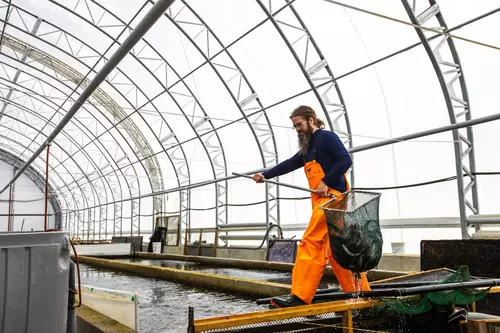Fabric Fishery Buildings
Modern fish farming requires precise control over environmental conditions to ensure optimal growth, health, and productivity. MegaDome fabric buildings offer an efficient, cost-effective solution tailored to the needs of aquaculture operations. Their spacious interiors, natural light (up to 30% with the agriculture membrane), and customizable ventilation systems help maintain ideal water quality and support sustainable fish production, whether you manage a hatchery, a grow-out facility, or a recirculating aquaculture system (RAS).
Economical
MegaDome’s fabric covers deliver a durable and cost-effective solution tailored for pisciculture. With easy customization and repair options, they harness natural light to help lower energy expenses, creating an optimal environment for aquaculture.
Low Operational Costs
Natural Light

Applications of MegaDome in Pisciculture
Fabric buildings offer unmatched versatility & adaptability, making them a popular choice across a wide range of fisheries and aquaculture buildings. Below are some of the most common applications for fabric structures in these settings.
- Fish Hatcheries
- Aquaculture
- Feed Storage
- Processing Facilities
- Equipment Storage
- Research Labs
- Water Filtration Facilities
Advantages of Fabric Fishery Constructions
Fabric fishery constructions offer numerous benefits for aquaculture operations, providing a cost-effective and durable solution tailored to the unique needs of the industry. These structures allow for ample natural light, reducing energy costs and creating a healthier environment for aquatic life. Their clear-span design maximizes usable space, accommodating tanks, equipment, and work areas without obstructions. Highly resistant to corrosion and moisture, fabric buildings are ideal for the humid conditions of fisheries, ensuring long-lasting performance.
Additionally, their customizable and portable nature makes them adaptable to changing operational requirements, supporting scalability as your fishery grows. You can select from a wide range of options, such as advanced ventilation systems, specialized access points, insulation, or even partitioned work zones. This flexibility allows you to create an environment optimized for hatcheries, grow-out facilities, or recirculating aquaculture systems (RAS), no matter how your operations evolve.
How Much Does It Cost to Build a Fabric Fishery Construction?
The cost of building a fabric fishery construction varies depending on size, design, and specific customizations required to meet your operational needs. Smaller structures designed for targeted aquaculture setups may be more affordable, while larger-scale constructions with added features like climate control, insulation, or specialized access points will increase the overall investment.
Fabric buildings for fishery and aquaculture buildings are generally more cost-effective than traditional structures, offering savings on materials (steel structures, Powershield membrane), labor, and energy expenses over time. Contact MegaDome for a detailed consultation and quote tailored to your fishery’s requirements, ensuring a budget-friendly solution without compromising on quality or functionality.
FAQs about Fabric Fishery & Aquaculture Buildings
How durable are fabric buildings in a fishery setting?
Fabric buildings used in fishery settings are engineered with corrosion-resistant steel frames and robust, industrial-grade fabric membranes. These materials are specifically chosen to handle the constant humidity, temperature fluctuations, and exposure to water or chemicals typical of aquaculture environments. With proper installation and minimal maintenance, fabric fishery buildings offer long-lasting protection for your operations and can withstand years of intensive use—even in coastal or challenging climates.
Can fabric fishery buildings be customized for specific needs?
Absolutely. Fabric buildings for fisheries are highly customizable to support your specific aquaculture requirements. Options include advanced ventilation systems to maintain water quality, high-performance insulation for temperature control, adjustable layout for tank placement and workflow optimization, as well as reinforced doors and access points for equipment. This flexibility ensures an ideal environment for aquatic life and allows your facility to evolve as your production scales up.
How do fabric buildings impact energy costs for fisheries?
Fabric fishery buildings are designed to maximize natural daylight, significantly reducing the need for artificial lighting and thus lowering electricity bills. Combined, these factors lead to major energy savings and improved operational efficiency, which is especially important for large-scale aquaculture facilities aiming to optimize their costs and reduce their environmental footprint.
Are fabric fishery buildings easy to maintain?
Yes, fabric buildings are known for their low maintenance needs. The durable fabric and structural elements are resistant to moisture, corrosion, and algae growth. Surfaces are smooth and easy to clean, which helps maintain sanitary conditions and reduces the frequency of repairs. Routine checks of the structure, membrane, and ventilation are usually sufficient to ensure optimal performance and longevity of your fishery building.
How much does it cost to build a fabric fishery construction?
The cost of building a fabric fishery construction depends on several factors, including the size of the building, the level of customization, and the technical features required (ventilation, insulation, access points, etc.). Smaller buildings for targeted uses will generally be more affordable, while larger, fully-equipped structures represent a higher investment but deliver long-term value through durability and efficiency. In all cases, fabric buildings are typically more cost-effective than traditional construction, both in terms of upfront costs and ongoing expenses. Contact MegaDome for a tailored quote and expert guidance on optimizing your investment.
Are fabric buildings suitable for use in harsh or coastal climates?
Yes, MegaDome fabric buildings are specifically engineered to perform in challenging environments, including harsh and coastal climates. The structures feature corrosion-resistant steel frames and durable, UV-stabilized fabric membranes that withstand exposure to salt air, high humidity, strong winds, and heavy precipitation. This makes them an ideal solution for fisheries and aquaculture facilities located near the coast or in regions with extreme weather conditions, providing reliable protection and long-term durability.
